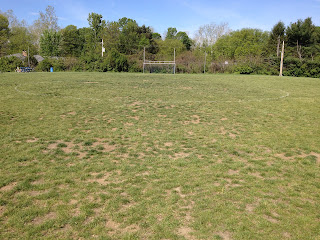Does your infield conditioner run off the infield during and after heavy rain events? Do you see erosion of infield mix during and after heavy rain events? If so, your infield has too much fall/pitch. As detailed in an earlier blog post, infield drainage should be accomplished with surface drainage, NOT subsurface drainage.
In the case of softball fields, there is no infield grass, but the sq. ft. of the infield is similar to a baseball infield - 10,000 sq. ft. Due to this fact, the fall/pitch on a softball infield has to be soft and very precise. I recommend softball fields to have a fall/pitch of .3%. This is due to two main reasons. One, a grade of .3% will allow for positive surface drainage, but will limit conditioner runoff. Secondly, due to the lack of a mound in softball, any conical grade more than .3% will create an illusion of a “mound.”
So, the question I get frequently is: “I have a field that is 10 years old, was not laser graded, and I have severe runoff issues. What can I do?”
Let’s go to Martinsville High School for a case study in how to address this issue.
Background:
The field was constructed approx. 15 years ago and was not laser graded. The field falls from the second base position to the third base dugout at a 2% slope. Needless to say, there is significant runoff issues. The first base dugout is 15 inches higher than the third base dugout. The infield has been amended with FieldSaver50 from the Natural Sand Company and Dura Edge Products.
The existing surface before renovation:
The Solution:
Starting over and rebuilding the dugouts and grading the infield with a conical laser is not an option. So, the plan is to soften the grade to .3% across the infield from the second base position to 5 feet past the third base line. Then the grade will fall at a 2% grade from the point 5 feet past the baseline to the dugout. Infield mix in front of the dugouts will be removed, six inches of topsoil installed as well as irrigation. The runoff will be eliminated with the installation of sod. Problem solved. Sod was installed in front of the first base dugout as well to balance the look of the field. Sod was placed up to the dugouts. Spring traffic patterns will be studied and small warning track “pads” will be installed in from of the dugout entrances.
The existing field, after renovation:
Bottom line, sometimes thinking outside of the box is necessary to create well draining fields that do not require a complete field renovation.
Play on!
--Jamie
@JamieMehringer












































